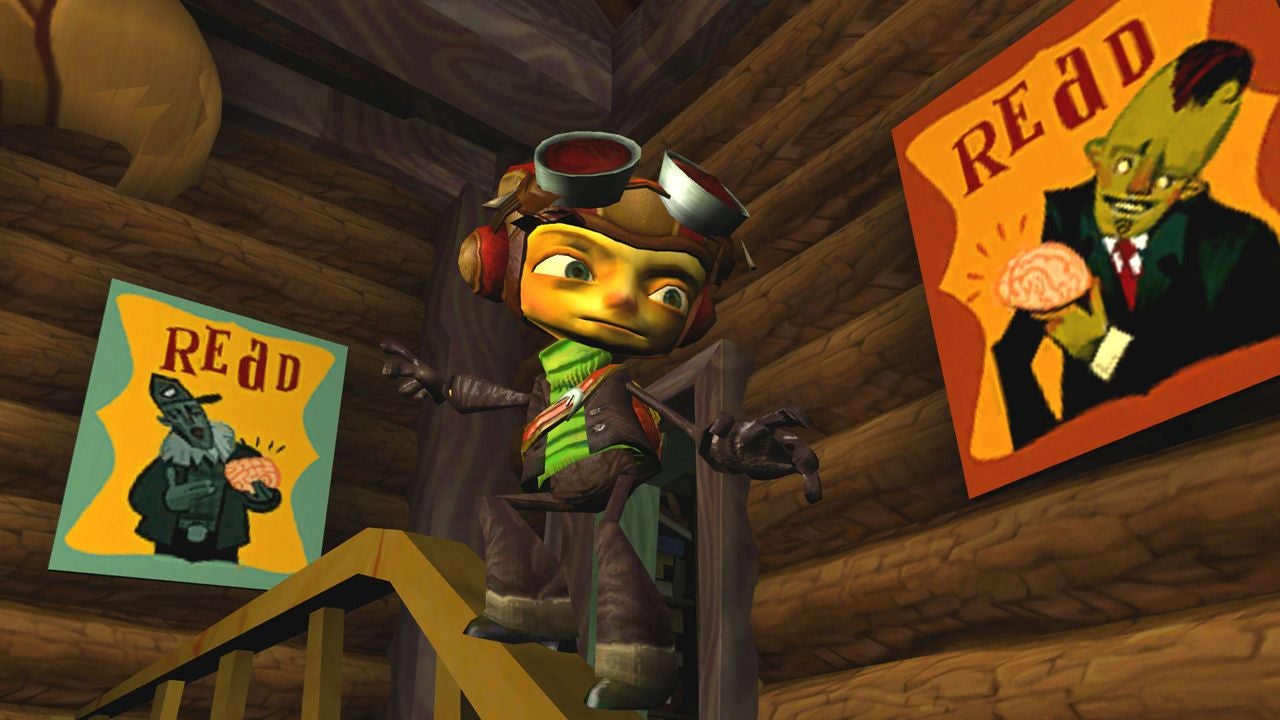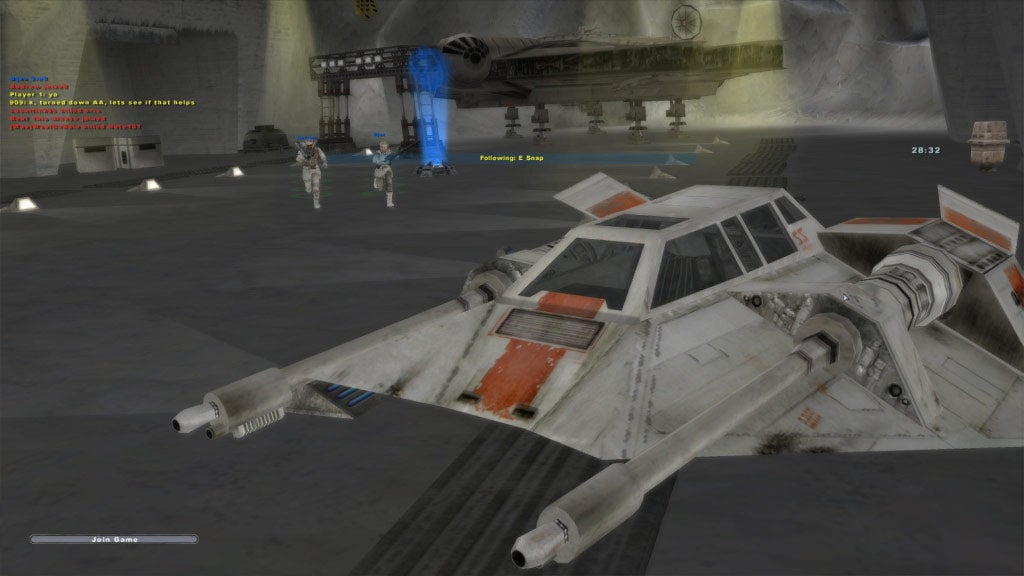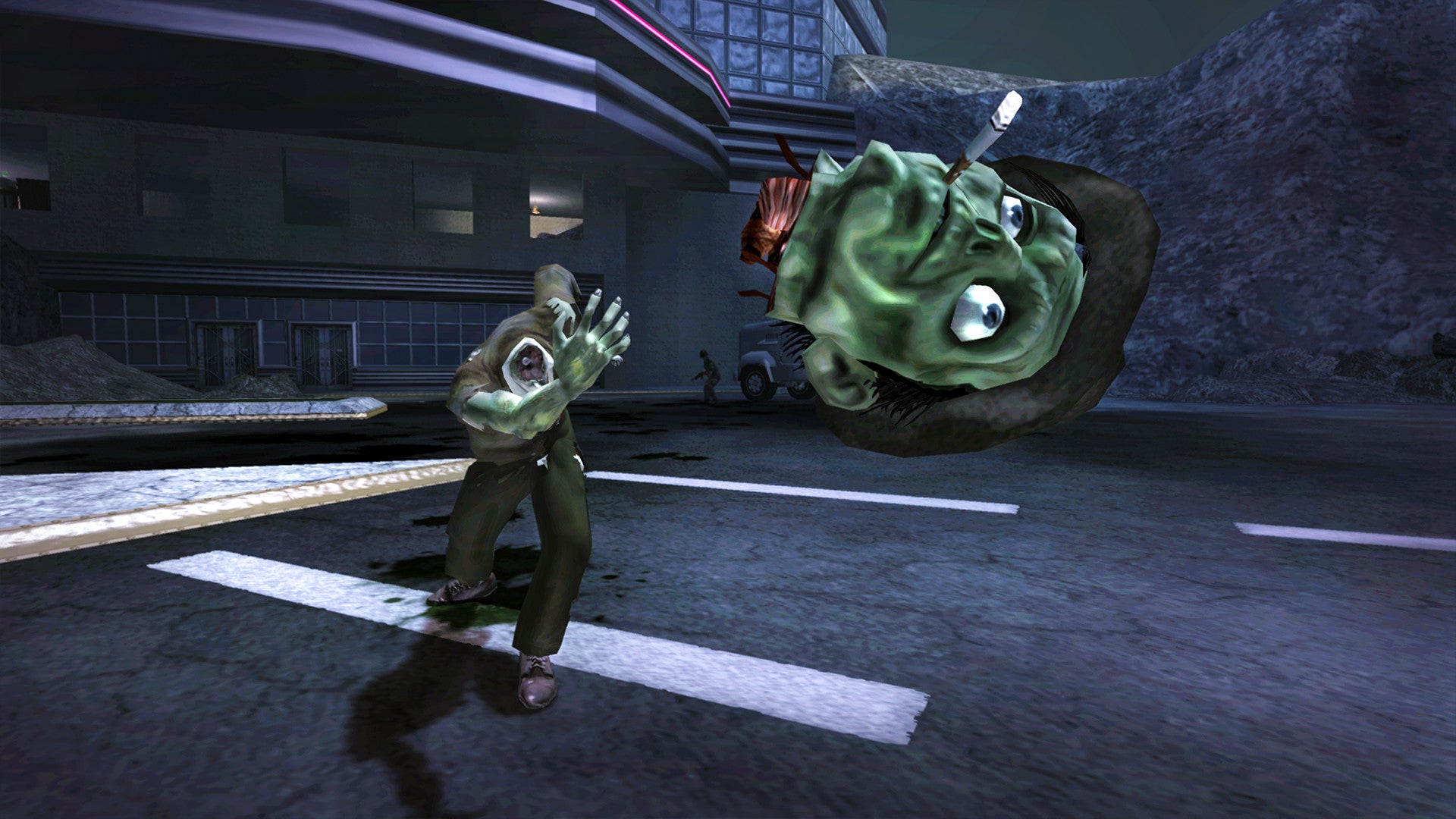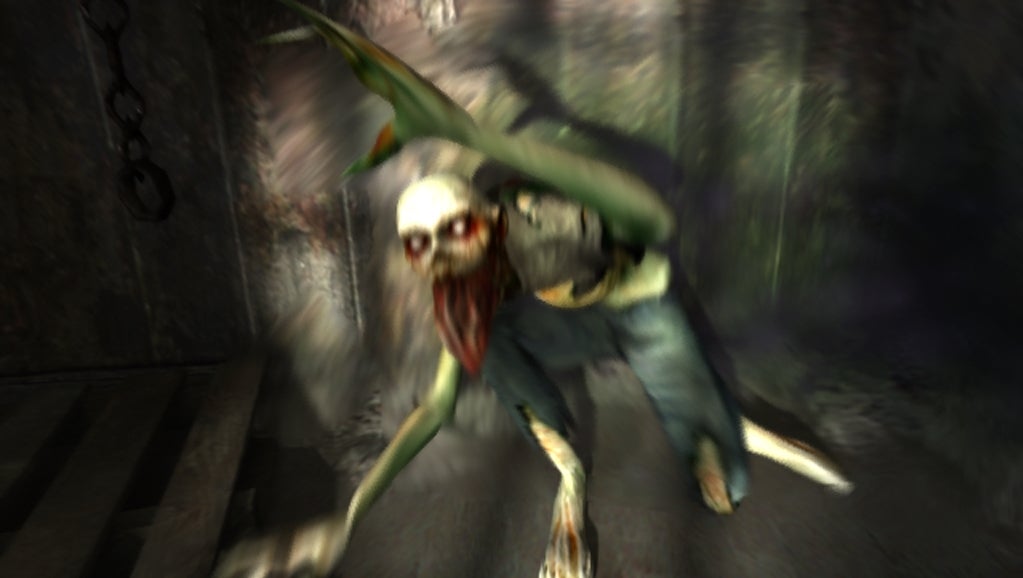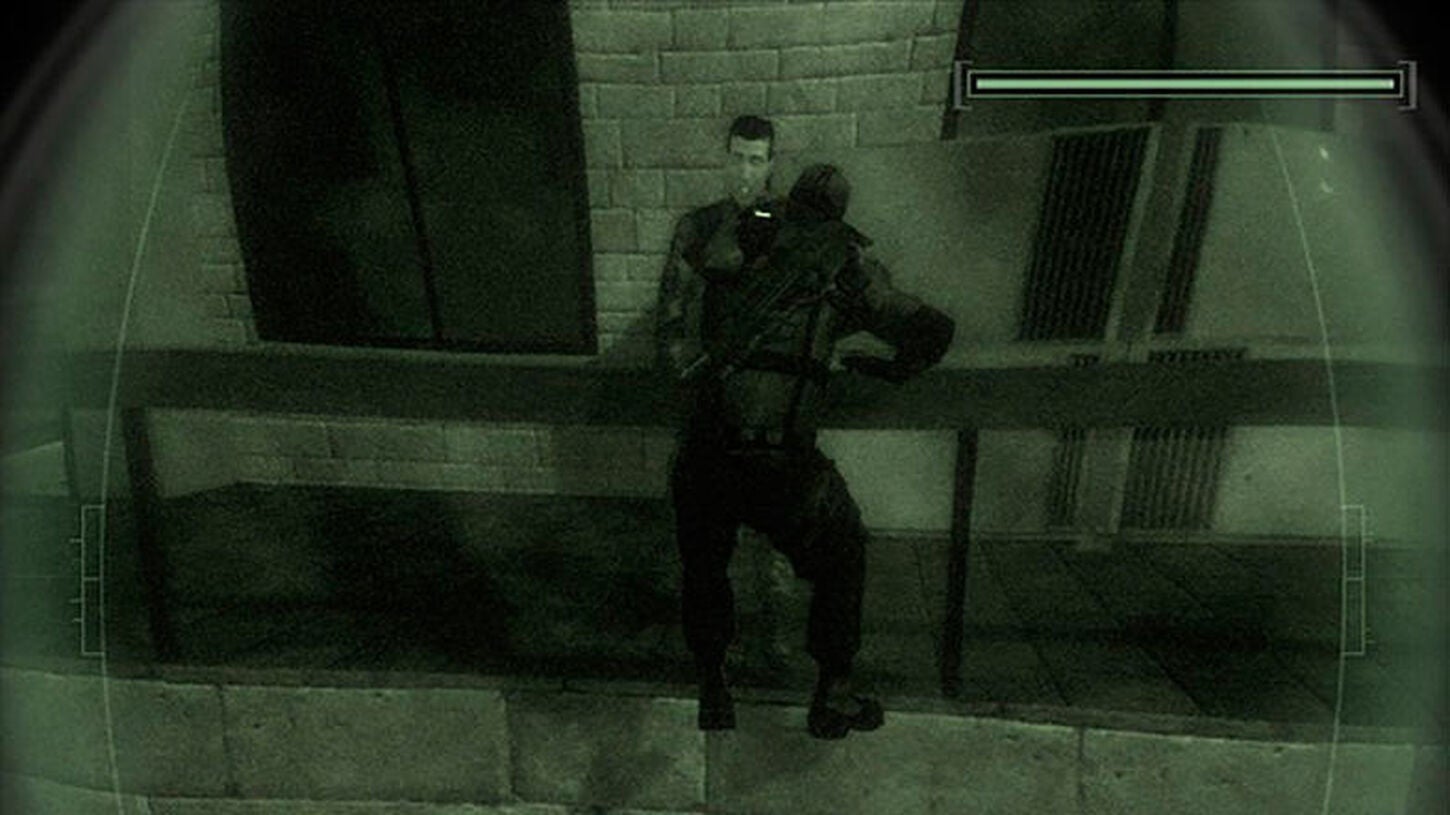The Time Capsule, of course, isn’t intended to be a list of the best games from the year in question, but rather a round up of the games we think are interesting or note-worthy enough to save for future generations. Sometimes there is overlap with “the best” and sometimes there isn’t. If a game has been remastered we have to justify which version of the game we pick, and we’re also going off the year a game came to PC - so if it came out on 2005 but only on consoles, no dice. Space in the Time Capsule is limited, and highly skewed by personal preference, which means we’ve probably left out your favourite. So why not make a case for your own Time Capsule pick in the comments below? Here we go.
Psychonauts
Alice Bee: I’m fairly sure every time I write about Psychonauts it’s to say “Look how good it is!?” in some way. Which makes sense. It regularly appears on best games of all time lists, and has a kind of mythical status reinforced by how commercially unsuccessful it was when it first came out. Double Fine were able to digitally re-release it a few years back, so we can all play this weirdo, psychadellic platformer and rightly appreciate it. One could argue if it’s worth preserving the original when Psychonauts 2 exists, but that’s a problem for future Alice. And in any case, the original (in which you play Raz, a trainee Psychonaut who can dive into people’s minds and run around the weird worlds inside) is such a great moonshot. It’s a singular vision that was a clear inspiration for so many other developers. It’s funny and imaginative and clearly doesn’t compromise on what the creators wanted it to be. Psychonauts wasn’t bad at the time, it was just before its time. Now its time has come again.
The Movies
CJ: Who hasn’t dreamt of becoming a director and making their own films? I was big into cinema in my late teens and early twenties; I fancied sitting in a folding chair all day, clutching a megaphone and barking gibberish at talented people who made films happen, regardless of what I did. Lionhead Studios’ The Movies was the closest I ever got to that fantasy, and it’s probably for the best. I was a terrible director, from what I recall of the many, many bad machinima shorts I cobbled together in the game’s movie editor. The Movies wasn’t just a typically Monyleuxian business simulator, full of little people wandering around a map as you plonked a variety of buildings down around them. No, in The Movies you really got to shoot aforesaid movies. It’s by no means a perfect game, but there’s just so much mucking about to be had in it that it deserves saving for posterity. You didn’t just hire actors, for example, you got them plastic surgery, or encouraged them towards alcoholism. Each game played out over decades as you built your movie empire, plopping out shocking classics that would embarrass even Alan Smithee. I remember particularly enjoying the early backdrops for driving scenes, which used static cars and a moving background. The Movies was like Theme Park, but crossed with every Hallmark Christmas movie you’ve ever “accidentally” watched every December for the past two decades. We had a small battle for the dubious privilege of picking this game for our Time Capsule entry, no joke. A fair few of us still have a soft spot for it even after 17 years. It’s such a shame that it has fallen into being abandonware, like many of Lionhead’s games from that time.
Star Wars: Battlefront 2
Hayden: A while back, I saved Pandemic’s Star Wars: Battlefront for the 2004 Time Capsule and sang its praises above the sequel. And now here I am, saving that sequel. So, what gives? Well, the truth is that I still have them both installed on Steam. That might seem odd, but I need them both because I gravitate towards them for different reasons. In fact, I’d go so far as to say that I’ll also probably save new Star Wars: Battlefront 2 if we get around to doing a 2017 Time Capsule at some point. Am I a goblin committed to a life of chaos? Maybe. But, while they might all be similar Star Wars shooty bangs, the Battlefront games each have slightly different vibes and one or two modes in which they shine above the rest. Battlefront 2’s biggest strength is the heroic antics you can achieve all on your own. The original Battlefront makes you feel like part of an army, just one stormtrooper amongst many others. Battlefront 2 places the emphasis firmly on becoming a one-person army, both on the ground and in space. During ground battles, you can become a Jedi or Sith, which the game refers to as a literal hero, and crush your opponents with a few swings of your laser sword. In space, you can singlehandedly destroy entire capital ships with just a few grenades. There’s no need for an army or support here, because Battlefront 2 is all about indulging in a Star Wars power fantasy, and it’s the best Battlefront has ever been at making you feel like a true hero. That does mean Conquest usually devolves into a race for kills so that you get picked as the hero for your team, but sometimes you just want to swing a lightsaber around and slice up some droids, ya know?
Civilization IV
Ollie: I joined the world of 4X games just as Civilization IV hit. I was around 10 years old, and I mostly knew the game because my dad played it a lot. More than any game I’d played before, Civilization IV felt like a game for grown-ups. After all, only grown-ups are allowed to commit mass slaughter and plunge the world into nuclear chaos. Every time I started a new game, I felt that I was embarking on a voyage. It was a tremendously exciting prospect, a real feeling of adventure. Perhaps it was my child’s mind and my inexperience with the 4X genre that gave me this feeling; but I think it’s more likely that with Civ IV, Firaxis had absolutely, positively perfected the atmosphere of venturing out into a new world, and slowly staking your claim on the land around you. The early-game of Civ IV is ingrained into my mind. I remember the lovely drums that play when you pop a goody hut, Genghis Khan’s marvellous beard, and wondering how annoying it must be for the AI leaders to hear me repeatedly say to them, “Let’s discuss something else” / “What do you think of…” / “Goodbye”. Don’t get me wrong, I’m all for the changes that have been made to the Civ formula since Civ IV. Hexagonal tiles are wonderful, and one-unit-per-tile is so much more interesting than amassing giant stacks of doom with which to steamroll through your enemies. But there’s still something about Civ IV that hasn’t been seen since. It’s probably the heady combination of Leonard Nimoy’s voice reading historical quotes after every researched technology, and the absolutely stunning soundtrack by Christopher Tin (Baba Yetu remains a contender for the greatest piece of game music ever made). To this day, it seems like many people say Civ IV is not only the best game in the series, but the best strategy game of all time. Nowadays there are other 4X games I enjoy more, but there’s no denying that Civ IV’s popularity and reputation in the genre is still legendary.
Black & White 2
Liam: Seeing as CJ quite rightly called dibs on The Movies, I’ve instead opted to reminisce about my second favourite Lionhead sim game released in 2005. I spent a lot of time with Black & White 2, but I’d be hard pressed to tell you if I ever actually understood what I was doing. Sure, I got that the goal was to help your villagers thrive. You could yank trees out of the ground before pouring them into buildings to help with construction. You could throw rocks at rival settlements. You could gently scold your giant wolf baby for pooping on a tiny man. Don’t do that, my large wolf son! The unknowable nature of B&W2 made a lot of its jank and mechanical limitations seem intentional, as if the game itself was actually very clever and that your creature would stop eating children if only you taught it better. This is a you issue, it seemed to silently imply. Be a better god. Come on now. The first game had this problem too, of course, but B&W2 polished off enough of the original’s pointy edges (read: shit mission design) to make the whole experience less frustrating. I think it works better as a sandbox to muck around in than it does as an actual game, but I remain very fond of it. It’s very tactile. Very pretty. You can tell a big cow to batter a lion. Lovely stuff. I miss Lionhead a lot. Sadly, you can’t buy it anywhere these days unless you manage to find a physical copy in a Cash Converters or something. Maybe there’s something poetic about that. If you ignore the wolf pooping bit. That kind of removes some of the mystique.
Stubbs The Zombie: Rebel Without A Pulse
Ed: Welcome to Punchbowl, a 50s retro-futuristic city where hovercars fly about, police wield laser pistols, and robots work at diners. Years ago you were a travelling salesman in a loving relationship with Maggie, until her father put a bullet through your chest and dumped you in the wilderness. Now you’re Stubbs The Zombie, and there’s a multi-billionaire dude who rules this city and he’s Maggie’s son and he sucks. There’s only one thing for it: brains. Eating brains, to be specific. You control Stubbs in a quest for revenge as you rampage around the city and chomp on the skulls of anyone who stands in your way. Anyone who succumbs to your rotten gnashers becomes a member of your undead army, which can be herded with a whistle or directed with a shove. And it’s not only your ability to create a shuffling horde, but your body parts that make combat such a laugh. You can tear your arm off and latch it onto an enemy’s head to mind-control them. You can use your head as an explosive bowling ball. I admire Stubbs because it’s a simple affair that largely sees you move from A to B chomping baddies and… not a lot else. Yet, the sheer satisfaction that comes from building a zombie army and the different tools at your disposal means that it rarely ever becomes a bore. Plus! I’ve not encountered another zombie game since that lets you play as a zombie commander, build a horde from a third-person perspective, and wrap it all in a package that doesn’t take itself too seriously. Bring him back.
The Sims 2: Nightlife
Rachel: I know I’m being a bit cheeky choosing an expansion pack, but hear me out. The GRIP that The Sims 2 had on me as a 12-year-old was unmatched. It was a monster that would eat my entire weekends in one chomp and gnaw on my evenings after school, and my infatuation was rewarded when The Sims 2: Nightlife released in September that year. EA might bring it to Origin one day, but playing The Sims 2 and all its expansion is a thing of the past now (unless you happen to have all the disks somewhere in your attic.) The first expansion, Sims 2: University, was okay I guess, but Nightlife was on a whole other level. Instead of fulfilling life goals, careers, and friendships, Nightlife was all about letting your Sims loose on the town. Downtown was a giant new lot complete with bowling alleys, karaoke machines, and dance floors. There was plenty to get stuck into and it was an expansion with great humour too, like the uptight, old lady Mrs. CrumpleBottom who would skulk around the clubs and bars, aggressively tutting and scolding Sims who were trying to have a saucy smooch. It set a standard. As my 12-year-old self had never been on a date, I saw the dating mini-game as some sort of weird ritual, and mastering the art of the ‘dream date’ was something I took major pride in. And vampires! Finding the elusive Grand Vampire on a night out was incredibly rare and when you did finally find one, you would have to spam them with drinks and teasing comments until you got bitten – that’s how flirting works, right?
Driver 3
James: Bear with me. Driver 3 was hopeless, to be sure, and if this Time Capsule thing were real, whoever opened it up to find Reflections’ quarter-baked wheelman sim would react in much the same way as if they’d just been bequeathed their grandfather’s third-favourite bedpan. It is a bad video game. And yet, it’s not the immediately repulsive kind of bad video game. It’s the kind slowly seeps its badness into you, adjusting the pH levels in the part of your brain where your standards live. Soon, you’re trundling around Driv3r’s barren, barely textured cities thinking… it’s kind of alright, actually? The car handling feels decent. The lighting looks quite nice. Ving Rhames is only mildly phoning it in. No! It’s a trick! Drivethreer is a generational big-budget mess, and coming to this realisation a few years after playing it felt like I’d escaped a cult. Riddled with bugs, nonsense physics and amateur animations, and with none of the charm or storytelling prowess that could paint over them, I can only cringe upon looking back and ever thinking it wasn’t as bad as everyone said. The worst thing I’d internalised as acceptable was the shooting: enemies wouldn’t move, and would only fire back if you were completely out in the open yourself. Thus, every fight could be easily won by hiding behind something solid, edging the crosshair around a corner until it settled on the next blind, immobile foe, and pulling the trigger until they flopped over. Dire. So dire, in fact, that Drive-thrur really needs preserving as much as 2005’s actually good games – just as a warning from history rather than a celebration of it.
F.E.A.R.
Alice0: After 17 years, F.E.A.R. is still cool. It is still cool to slide-kick into a baddie to launch them then slip into slow mo to blast them with your shotgun. It is still cool for shotguns to dissemble baddies into their component guts. It is still cool to batter baddies with a spinning roundhouse kick. It is still cool to take helicopter rides between mission sites. It is still cool for a straightforward man-shooting mission to creep into supernatural horror. It is still cool to zap a baddie with a lightning gun which leaves a charred skeleton in their place. It is still cool for horrible cloaked baddies to scamper away and leap into the suspended ceiling after swiping at you. It is still cool to have lots of unnerving quiet time. Hell, even the jumpscares interrupting those moments are still cool.
ObsCure
Rebecca: I wouldn’t learn about the existence of ObsCure until long after the fact; I hadn’t even heard of this game until the late 2010s, when my interest in the history of horror led me in its direction. Seen in a retrospective context it’s a fascinating relic of the period that bridged the gap between classic and modern survival horror. Despite its age and its standard-issue mid-2000s action, ObsCure does a lot of things with its concept that feel very modern. Resident Evil and Alone In The Dark had already established the idea of presenting you with a choice of playable characters taking different routes through the game, but in ObsCure you’re given the opportunity to switch between five playable protagonists who are all embarking on the same story. A second character will accompany you throughout, either AI-controlled or played by a friend in local co-op. If a character dies, the story continues without them. Throw in the high-camp use of the high school setting and tropey teen protagonists, and you’ve got a fascinating early example of something that’s bang on trend again today, and in fact is the bread-and-butter of studios like Supermassive Games. All it’s missing is online multiplayer, really. Unlike many games with ideas well ahead of their time, ObsCure has aged fairly well. New players can pick it up without having to unlearn and relearn nearly two decades’ worth of motor skills, at least. In fact, despite releasing to mixed reviews in its day, it’s now proclaimed Overwhelmingly Positive on Steam. Playing ObsCure on PC in 2022, it could easily pass for a modern indie game going for the retro PS2-era horror vibe. A little clunky in places and hard as nails, but that was the style at the time.
Splinter Cell: Chaos Theory
Katharine: I had to take an unexpected leave of absence recently, so by the time I came to stuffing my game of choice into this month’s Time Capsule, it was pretty slim pickings. Of the games left from 2005, it turns out I hadn’t actually played a single one of them, so I’m cheesing it a bit this month by going with Splinter Cell: Chaos Theory - the 2005 game I would most like to add to my backlog to play in the future. Regularly held up as the best Splinter Cell game in the series, this stealth shooter series has always intrigued me from afar. I never owned a powerful enough PC at the time, nor did I have any of the other consoles it originally came out on, but it’s a game I’ve always wanted to try. Now, you could say the stealth genre has since been perfected by IO Interactive’s recent Hitman World Of Assassination trilogy, but I’d argue that Chaos Theory is the perfect foil to Agent 47’s exotic globetrotting. Whereas Agent 47 operates in plain sight, Sam Fisher prefers the cover of complete darkness, swapping disguises for his iconic, three-pronged goggles that let players switch between classic night vision, thermal imaging and the new addition of EMF emissions. He also had a wide array of gadgets and gun attachments that almost veered into the realms of the immersive sim at times, and its open-ended levels still look pretty darn great even by today’s standards. Plus, you can take down enemies while hanging from a pipe! And do the splits on tight corridor walls to avoid being seen! Now that’s something that’s definitely worth preserving.
